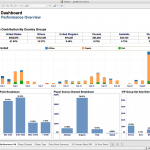Data and the Cloud: What are the implications of the 21st Century Digital Frontier
According to a study conducted by Forbes, more data was created during the past two
years than in all previous years in human history combined. By as soon as 2020, there
will be 44 trillion gigabytes of data in the world – or roughly 1.7 new megabytes of data
being created for every person every second.
In an effort to not only store this huge volume of data but to make sense of it in an appreciable way, many are turning to the cloud to solve all of their problems at once. While data and the cloud do have a naturally beneficial relationship, the “brave new world” of online information that we’re now living in does require you to keep a few key things in mind.
The Advantages of the Cloud: Practical Applications
Perhaps the biggest benefit that the cloud brings to the table in terms of its various applications is one of empowerment. In just a few short years, it has completely upended the way many different types of businesses and even entire sectors operate – almost universally for the better.
Take healthcare, for just one example. Two decades ago, if you visited a new doctor for the first time you would probably be greeted with a clipboard filled with six or more sheets of paper to fill out about your medical history, your reason for visiting, medication you’re taking and more. Those sheets would then be stored in a filing cabinet in that same physical location, to be located and used as necessary. If you needed to change doctors for whatever reason, your old doctor’s office would have to physically send that information to your new doctor – or you would have to fill it all out again. While this was comprehensive, it was hardly efficient.
Flash forward to today, and a new doctor’s visit can involve a receptionist handing you a tablet where you enter all the same information. Thanks to the fact that this data is stored in the cloud, any doctor in the office can access it from any computer, tablet or other mobile device they need instantly. If you switch doctors, you’re not at the will of the United States Postal Service – your new office can now access that information instantly upon request as well.
The implications are much broader than that, however. Law enforcement would be another example of an industry using data and the cloud to “work smarter, not harder.” Gone are the days where every mission-critical piece of enforcement information HAD to be given out during a shift briefing at the station. If any new developments on a case happen, or if a breaking alert is issued, it can be pushed out to officers in the field automatically thanks to the cloud. They can also submit incident reports and other documents without taking time out of their busy schedule to leave the streets they’re protecting and return to the station. Police and other law enforcement professionals are now more connected than ever, even if they’re not “physically” connected at all.
The same is true in the world of business. Once data is stored in the cloud, business data analytics solutions can be deployed that allow entire organizations to gain a deeper, much more organic level of insight and perspective into their operations. They’re no longer just looking at numbers on a page – they can use these intelligent solutions to uncover the story BEYOND the numbers. Visualization and analytical tools like Google Analytics, Tableau, Looker and others can make performance measures not only visible to decision makers and other thought leaders, but they can do this in real-time.
Meaningful insights from data happen in an instant, allowing them to make the highest quality, proactive decisions without delay.

The Cloud and Control: Major Considerations
On the other hand, the cloud does require an organization to give up a certain degree of control over its data. When a healthcare organization stores patient records in hard copies in a filing cabinet, they know exactly where that data is at all times – locked away in an office. In the cloud, it’s not even physically stored on a hard drive – it can be in a data center halfway around the country or the world. This requires a certain level of trust in a cloud services provider, particularly when it comes to keeping that data safe.
According to a study conducted by IBM, the average cost of a single data breach in 2016 rose to an all-time high of $4 million. This also transitions directly into another concern – compliance. Not all cloud solutions are created equally, which is why it is imperative for organizations to invest in a provider that can not only offer them the features they need, but the security their industry demands. Healthcare organizations would have to make sure their cloud solution is compliant with HIPAA, for example.
To say that the cloud is a massive benefit to nearly every industry that you can think of is something of an understatement. The insights gain by data analytics alone are worth the initial investment for many. As with any “new” technology, however, this is not a decision that should be made lightly. Only once you understand what you stand to gain AND what you stand to lose in the worst case scenario will you be in the best position to make the right call for you and your team.
Visit our homepage, subscribe to more articles and updates








